Feminist Discourse and Representation of Women in Advertisements
VerifiedAdded on 2022/07/28
|8
|1588
|18
Essay
AI Summary
This essay delves into the feminist discourse and the representation of women in contemporary advertisements, examining how gender is socially constructed and how these constructions are reflected in media campaigns. The study focuses on the theoretical understanding of both 'advertising discourse' and 'feminist discourse,' analyzing femininity as a social construct. It analyzes three advertisement campaigns: Budweiser's International Women's Day campaign, P&G's #LikeAGirl campaign, and Reebok's #BEMOREHUMAN campaign, highlighting how these campaigns challenge traditional gender stereotypes and promote women empowerment, individuality, and intersectionality. The essay explores the evolution of advertising discourse, influenced by social media and the internet, and the emergence of Femvertising, a marketing strategy that aims to empower and inspire women. The analysis reveals a shift from conventional gender stereotypes to narratives that celebrate women's capacity, strength, and potential, aligning with the principles of fourth-wave feminism. References to academic sources are provided for further research.
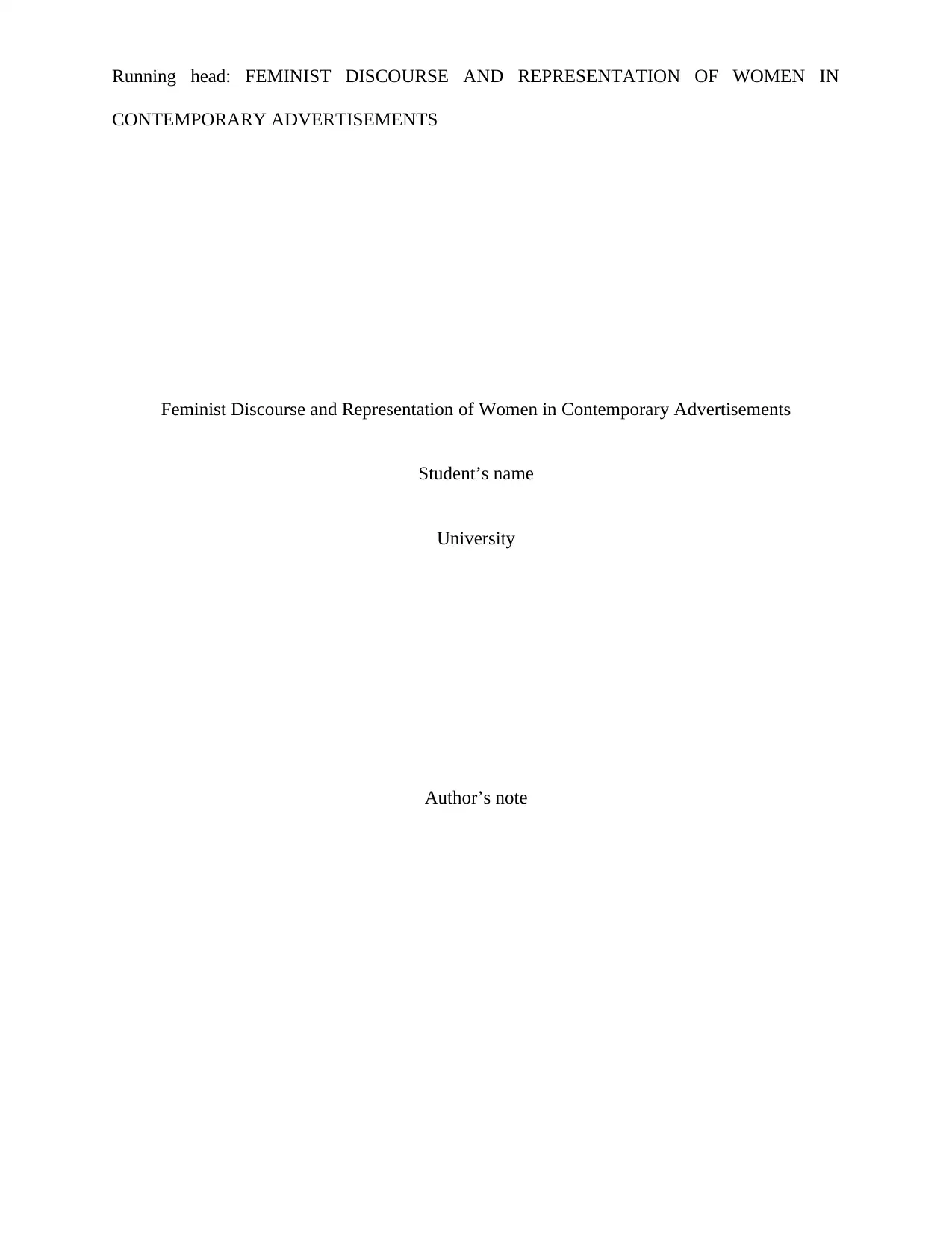
Running head: FEMINIST DISCOURSE AND REPRESENTATION OF WOMEN IN
CONTEMPORARY ADVERTISEMENTS
Feminist Discourse and Representation of Women in Contemporary Advertisements
Student’s name
University
Author’s note
CONTEMPORARY ADVERTISEMENTS
Feminist Discourse and Representation of Women in Contemporary Advertisements
Student’s name
University
Author’s note
Paraphrase This Document
Need a fresh take? Get an instant paraphrase of this document with our AI Paraphraser
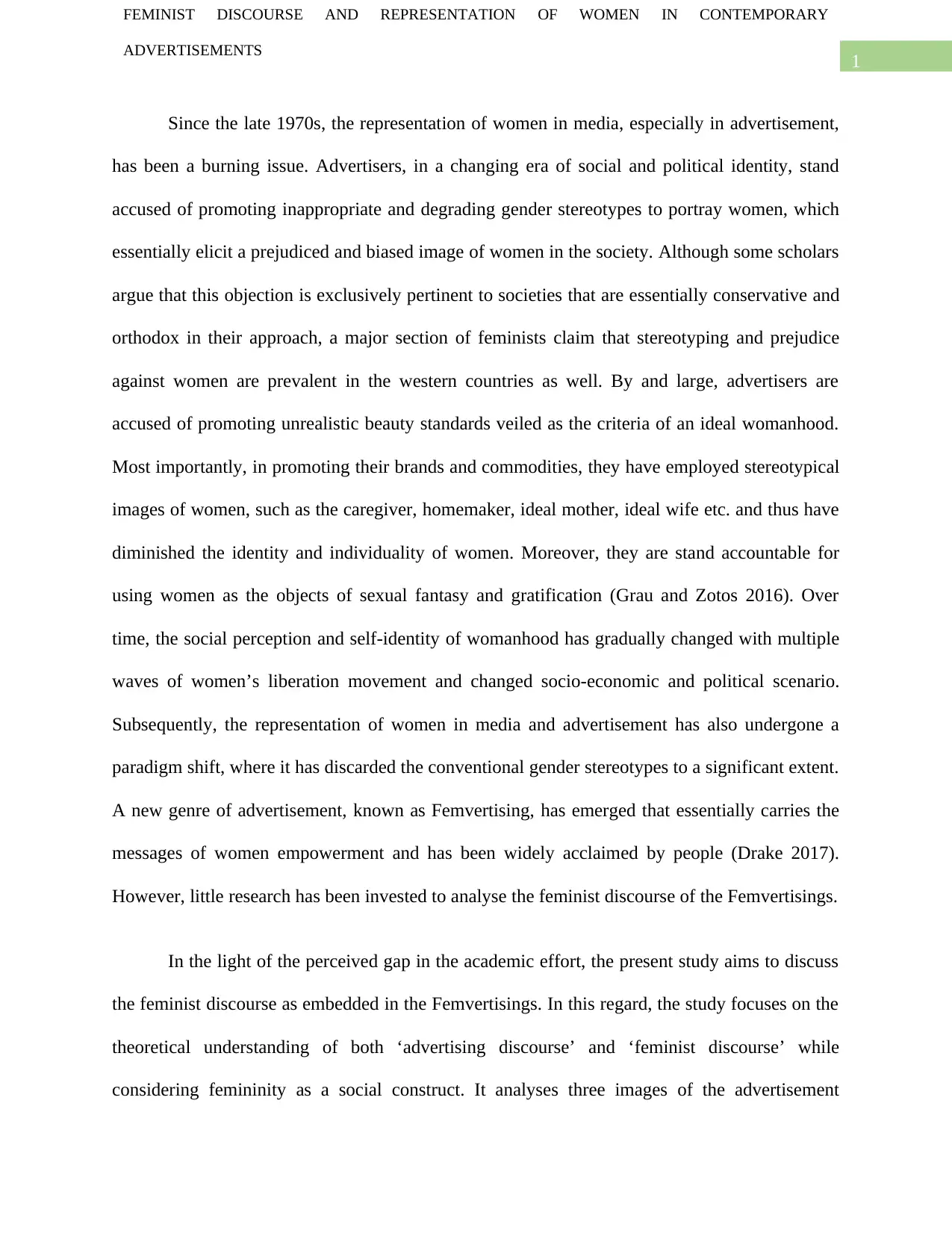
1
FEMINIST DISCOURSE AND REPRESENTATION OF WOMEN IN CONTEMPORARY
ADVERTISEMENTS
Since the late 1970s, the representation of women in media, especially in advertisement,
has been a burning issue. Advertisers, in a changing era of social and political identity, stand
accused of promoting inappropriate and degrading gender stereotypes to portray women, which
essentially elicit a prejudiced and biased image of women in the society. Although some scholars
argue that this objection is exclusively pertinent to societies that are essentially conservative and
orthodox in their approach, a major section of feminists claim that stereotyping and prejudice
against women are prevalent in the western countries as well. By and large, advertisers are
accused of promoting unrealistic beauty standards veiled as the criteria of an ideal womanhood.
Most importantly, in promoting their brands and commodities, they have employed stereotypical
images of women, such as the caregiver, homemaker, ideal mother, ideal wife etc. and thus have
diminished the identity and individuality of women. Moreover, they are stand accountable for
using women as the objects of sexual fantasy and gratification (Grau and Zotos 2016). Over
time, the social perception and self-identity of womanhood has gradually changed with multiple
waves of women’s liberation movement and changed socio-economic and political scenario.
Subsequently, the representation of women in media and advertisement has also undergone a
paradigm shift, where it has discarded the conventional gender stereotypes to a significant extent.
A new genre of advertisement, known as Femvertising, has emerged that essentially carries the
messages of women empowerment and has been widely acclaimed by people (Drake 2017).
However, little research has been invested to analyse the feminist discourse of the Femvertisings.
In the light of the perceived gap in the academic effort, the present study aims to discuss
the feminist discourse as embedded in the Femvertisings. In this regard, the study focuses on the
theoretical understanding of both ‘advertising discourse’ and ‘feminist discourse’ while
considering femininity as a social construct. It analyses three images of the advertisement
FEMINIST DISCOURSE AND REPRESENTATION OF WOMEN IN CONTEMPORARY
ADVERTISEMENTS
Since the late 1970s, the representation of women in media, especially in advertisement,
has been a burning issue. Advertisers, in a changing era of social and political identity, stand
accused of promoting inappropriate and degrading gender stereotypes to portray women, which
essentially elicit a prejudiced and biased image of women in the society. Although some scholars
argue that this objection is exclusively pertinent to societies that are essentially conservative and
orthodox in their approach, a major section of feminists claim that stereotyping and prejudice
against women are prevalent in the western countries as well. By and large, advertisers are
accused of promoting unrealistic beauty standards veiled as the criteria of an ideal womanhood.
Most importantly, in promoting their brands and commodities, they have employed stereotypical
images of women, such as the caregiver, homemaker, ideal mother, ideal wife etc. and thus have
diminished the identity and individuality of women. Moreover, they are stand accountable for
using women as the objects of sexual fantasy and gratification (Grau and Zotos 2016). Over
time, the social perception and self-identity of womanhood has gradually changed with multiple
waves of women’s liberation movement and changed socio-economic and political scenario.
Subsequently, the representation of women in media and advertisement has also undergone a
paradigm shift, where it has discarded the conventional gender stereotypes to a significant extent.
A new genre of advertisement, known as Femvertising, has emerged that essentially carries the
messages of women empowerment and has been widely acclaimed by people (Drake 2017).
However, little research has been invested to analyse the feminist discourse of the Femvertisings.
In the light of the perceived gap in the academic effort, the present study aims to discuss
the feminist discourse as embedded in the Femvertisings. In this regard, the study focuses on the
theoretical understanding of both ‘advertising discourse’ and ‘feminist discourse’ while
considering femininity as a social construct. It analyses three images of the advertisement
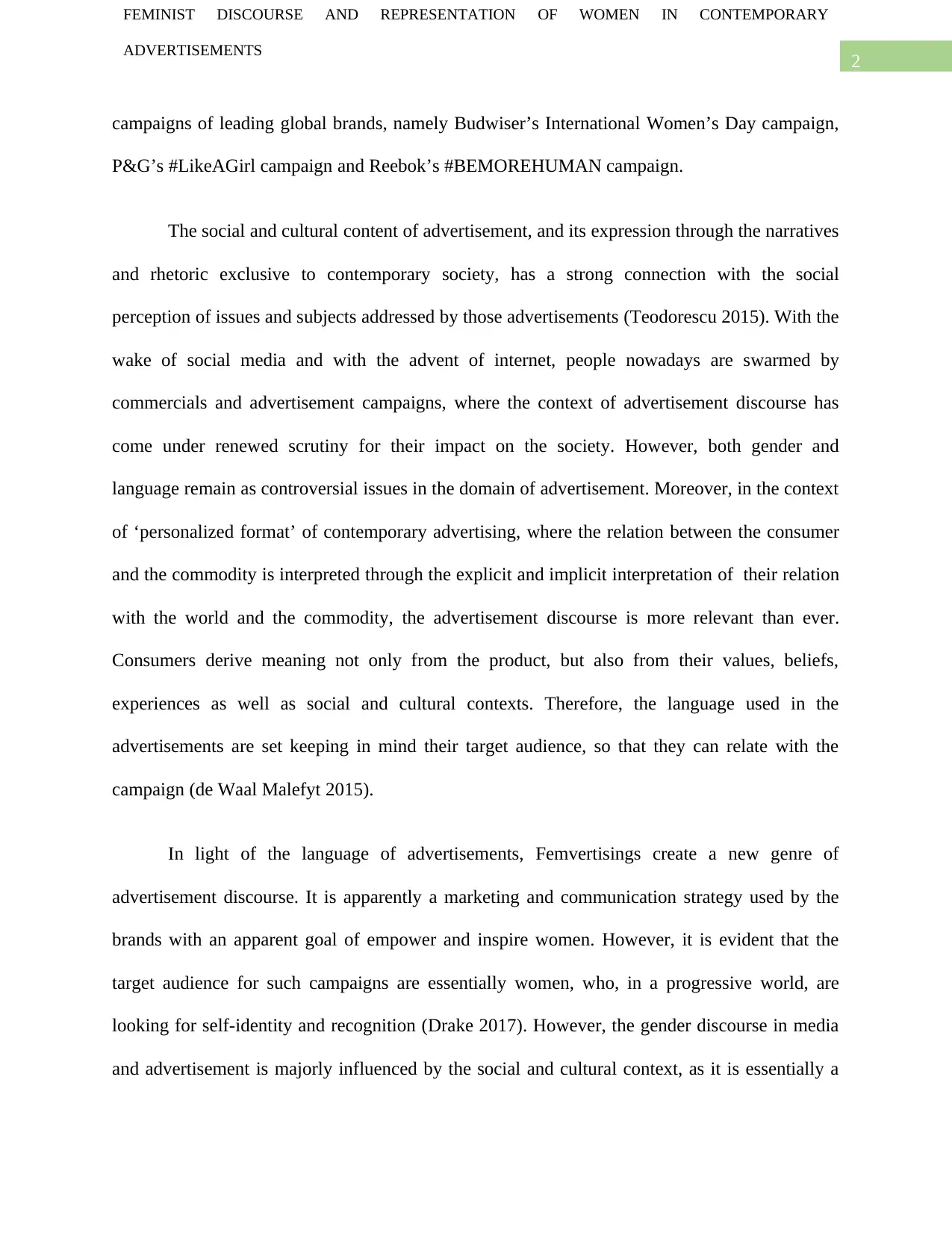
2
FEMINIST DISCOURSE AND REPRESENTATION OF WOMEN IN CONTEMPORARY
ADVERTISEMENTS
campaigns of leading global brands, namely Budwiser’s International Women’s Day campaign,
P&G’s #LikeAGirl campaign and Reebok’s #BEMOREHUMAN campaign.
The social and cultural content of advertisement, and its expression through the narratives
and rhetoric exclusive to contemporary society, has a strong connection with the social
perception of issues and subjects addressed by those advertisements (Teodorescu 2015). With the
wake of social media and with the advent of internet, people nowadays are swarmed by
commercials and advertisement campaigns, where the context of advertisement discourse has
come under renewed scrutiny for their impact on the society. However, both gender and
language remain as controversial issues in the domain of advertisement. Moreover, in the context
of ‘personalized format’ of contemporary advertising, where the relation between the consumer
and the commodity is interpreted through the explicit and implicit interpretation of their relation
with the world and the commodity, the advertisement discourse is more relevant than ever.
Consumers derive meaning not only from the product, but also from their values, beliefs,
experiences as well as social and cultural contexts. Therefore, the language used in the
advertisements are set keeping in mind their target audience, so that they can relate with the
campaign (de Waal Malefyt 2015).
In light of the language of advertisements, Femvertisings create a new genre of
advertisement discourse. It is apparently a marketing and communication strategy used by the
brands with an apparent goal of empower and inspire women. However, it is evident that the
target audience for such campaigns are essentially women, who, in a progressive world, are
looking for self-identity and recognition (Drake 2017). However, the gender discourse in media
and advertisement is majorly influenced by the social and cultural context, as it is essentially a
FEMINIST DISCOURSE AND REPRESENTATION OF WOMEN IN CONTEMPORARY
ADVERTISEMENTS
campaigns of leading global brands, namely Budwiser’s International Women’s Day campaign,
P&G’s #LikeAGirl campaign and Reebok’s #BEMOREHUMAN campaign.
The social and cultural content of advertisement, and its expression through the narratives
and rhetoric exclusive to contemporary society, has a strong connection with the social
perception of issues and subjects addressed by those advertisements (Teodorescu 2015). With the
wake of social media and with the advent of internet, people nowadays are swarmed by
commercials and advertisement campaigns, where the context of advertisement discourse has
come under renewed scrutiny for their impact on the society. However, both gender and
language remain as controversial issues in the domain of advertisement. Moreover, in the context
of ‘personalized format’ of contemporary advertising, where the relation between the consumer
and the commodity is interpreted through the explicit and implicit interpretation of their relation
with the world and the commodity, the advertisement discourse is more relevant than ever.
Consumers derive meaning not only from the product, but also from their values, beliefs,
experiences as well as social and cultural contexts. Therefore, the language used in the
advertisements are set keeping in mind their target audience, so that they can relate with the
campaign (de Waal Malefyt 2015).
In light of the language of advertisements, Femvertisings create a new genre of
advertisement discourse. It is apparently a marketing and communication strategy used by the
brands with an apparent goal of empower and inspire women. However, it is evident that the
target audience for such campaigns are essentially women, who, in a progressive world, are
looking for self-identity and recognition (Drake 2017). However, the gender discourse in media
and advertisement is majorly influenced by the social and cultural context, as it is essentially a
⊘ This is a preview!⊘
Do you want full access?
Subscribe today to unlock all pages.

Trusted by 1+ million students worldwide
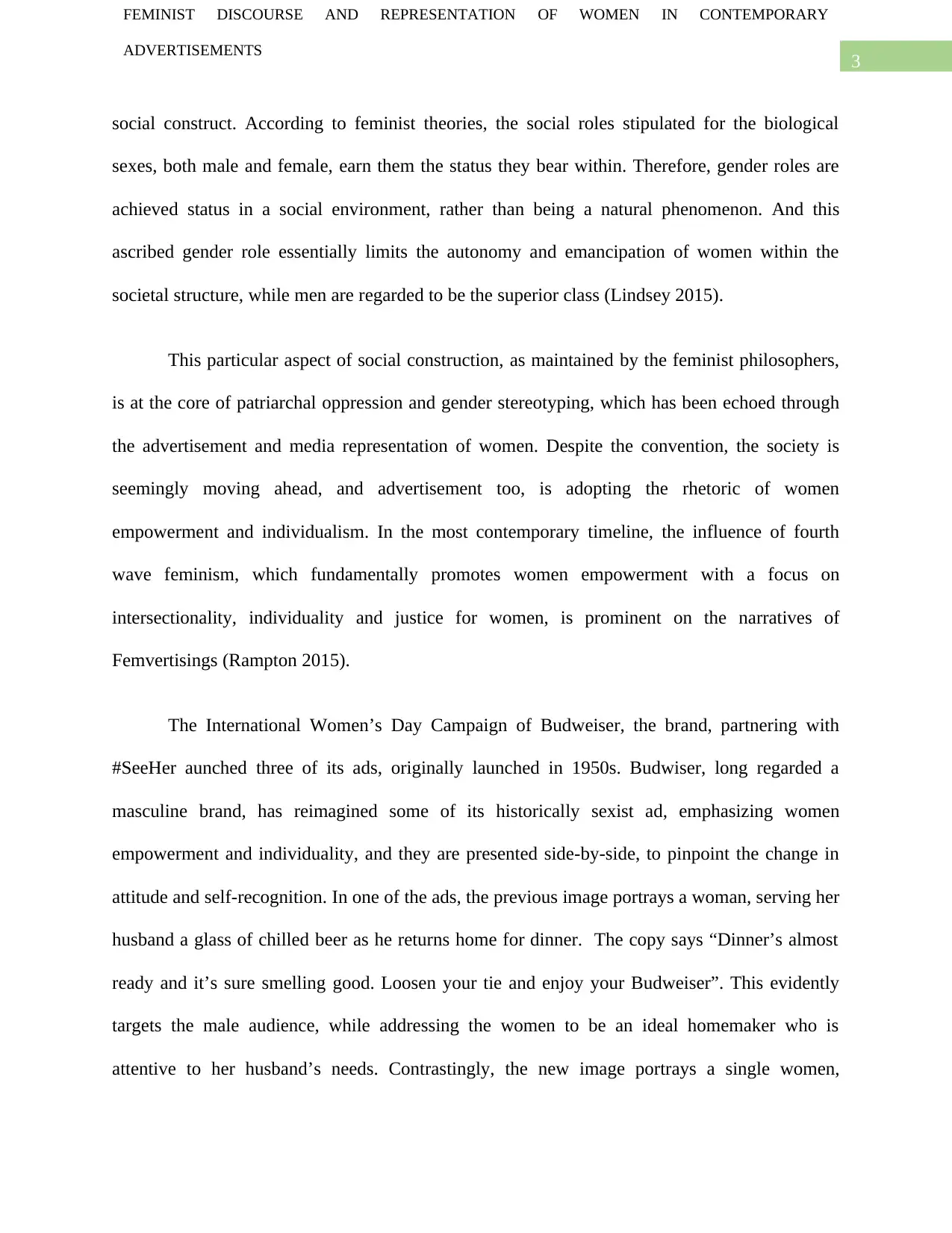
3
FEMINIST DISCOURSE AND REPRESENTATION OF WOMEN IN CONTEMPORARY
ADVERTISEMENTS
social construct. According to feminist theories, the social roles stipulated for the biological
sexes, both male and female, earn them the status they bear within. Therefore, gender roles are
achieved status in a social environment, rather than being a natural phenomenon. And this
ascribed gender role essentially limits the autonomy and emancipation of women within the
societal structure, while men are regarded to be the superior class (Lindsey 2015).
This particular aspect of social construction, as maintained by the feminist philosophers,
is at the core of patriarchal oppression and gender stereotyping, which has been echoed through
the advertisement and media representation of women. Despite the convention, the society is
seemingly moving ahead, and advertisement too, is adopting the rhetoric of women
empowerment and individualism. In the most contemporary timeline, the influence of fourth
wave feminism, which fundamentally promotes women empowerment with a focus on
intersectionality, individuality and justice for women, is prominent on the narratives of
Femvertisings (Rampton 2015).
The International Women’s Day Campaign of Budweiser, the brand, partnering with
#SeeHer aunched three of its ads, originally launched in 1950s. Budwiser, long regarded a
masculine brand, has reimagined some of its historically sexist ad, emphasizing women
empowerment and individuality, and they are presented side-by-side, to pinpoint the change in
attitude and self-recognition. In one of the ads, the previous image portrays a woman, serving her
husband a glass of chilled beer as he returns home for dinner. The copy says “Dinner’s almost
ready and it’s sure smelling good. Loosen your tie and enjoy your Budweiser”. This evidently
targets the male audience, while addressing the women to be an ideal homemaker who is
attentive to her husband’s needs. Contrastingly, the new image portrays a single women,
FEMINIST DISCOURSE AND REPRESENTATION OF WOMEN IN CONTEMPORARY
ADVERTISEMENTS
social construct. According to feminist theories, the social roles stipulated for the biological
sexes, both male and female, earn them the status they bear within. Therefore, gender roles are
achieved status in a social environment, rather than being a natural phenomenon. And this
ascribed gender role essentially limits the autonomy and emancipation of women within the
societal structure, while men are regarded to be the superior class (Lindsey 2015).
This particular aspect of social construction, as maintained by the feminist philosophers,
is at the core of patriarchal oppression and gender stereotyping, which has been echoed through
the advertisement and media representation of women. Despite the convention, the society is
seemingly moving ahead, and advertisement too, is adopting the rhetoric of women
empowerment and individualism. In the most contemporary timeline, the influence of fourth
wave feminism, which fundamentally promotes women empowerment with a focus on
intersectionality, individuality and justice for women, is prominent on the narratives of
Femvertisings (Rampton 2015).
The International Women’s Day Campaign of Budweiser, the brand, partnering with
#SeeHer aunched three of its ads, originally launched in 1950s. Budwiser, long regarded a
masculine brand, has reimagined some of its historically sexist ad, emphasizing women
empowerment and individuality, and they are presented side-by-side, to pinpoint the change in
attitude and self-recognition. In one of the ads, the previous image portrays a woman, serving her
husband a glass of chilled beer as he returns home for dinner. The copy says “Dinner’s almost
ready and it’s sure smelling good. Loosen your tie and enjoy your Budweiser”. This evidently
targets the male audience, while addressing the women to be an ideal homemaker who is
attentive to her husband’s needs. Contrastingly, the new image portrays a single women,
Paraphrase This Document
Need a fresh take? Get an instant paraphrase of this document with our AI Paraphraser
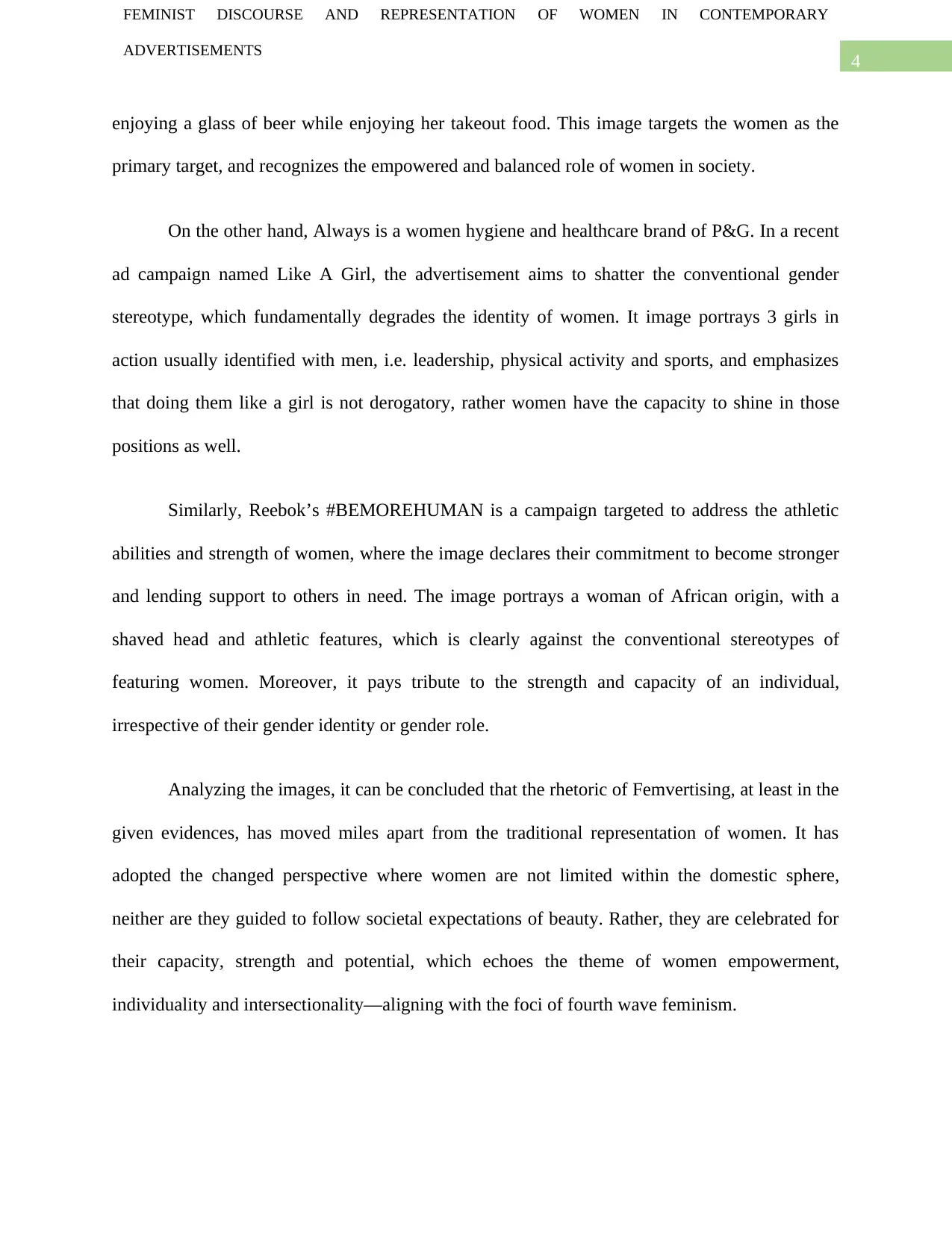
4
FEMINIST DISCOURSE AND REPRESENTATION OF WOMEN IN CONTEMPORARY
ADVERTISEMENTS
enjoying a glass of beer while enjoying her takeout food. This image targets the women as the
primary target, and recognizes the empowered and balanced role of women in society.
On the other hand, Always is a women hygiene and healthcare brand of P&G. In a recent
ad campaign named Like A Girl, the advertisement aims to shatter the conventional gender
stereotype, which fundamentally degrades the identity of women. It image portrays 3 girls in
action usually identified with men, i.e. leadership, physical activity and sports, and emphasizes
that doing them like a girl is not derogatory, rather women have the capacity to shine in those
positions as well.
Similarly, Reebok’s #BEMOREHUMAN is a campaign targeted to address the athletic
abilities and strength of women, where the image declares their commitment to become stronger
and lending support to others in need. The image portrays a woman of African origin, with a
shaved head and athletic features, which is clearly against the conventional stereotypes of
featuring women. Moreover, it pays tribute to the strength and capacity of an individual,
irrespective of their gender identity or gender role.
Analyzing the images, it can be concluded that the rhetoric of Femvertising, at least in the
given evidences, has moved miles apart from the traditional representation of women. It has
adopted the changed perspective where women are not limited within the domestic sphere,
neither are they guided to follow societal expectations of beauty. Rather, they are celebrated for
their capacity, strength and potential, which echoes the theme of women empowerment,
individuality and intersectionality—aligning with the foci of fourth wave feminism.
FEMINIST DISCOURSE AND REPRESENTATION OF WOMEN IN CONTEMPORARY
ADVERTISEMENTS
enjoying a glass of beer while enjoying her takeout food. This image targets the women as the
primary target, and recognizes the empowered and balanced role of women in society.
On the other hand, Always is a women hygiene and healthcare brand of P&G. In a recent
ad campaign named Like A Girl, the advertisement aims to shatter the conventional gender
stereotype, which fundamentally degrades the identity of women. It image portrays 3 girls in
action usually identified with men, i.e. leadership, physical activity and sports, and emphasizes
that doing them like a girl is not derogatory, rather women have the capacity to shine in those
positions as well.
Similarly, Reebok’s #BEMOREHUMAN is a campaign targeted to address the athletic
abilities and strength of women, where the image declares their commitment to become stronger
and lending support to others in need. The image portrays a woman of African origin, with a
shaved head and athletic features, which is clearly against the conventional stereotypes of
featuring women. Moreover, it pays tribute to the strength and capacity of an individual,
irrespective of their gender identity or gender role.
Analyzing the images, it can be concluded that the rhetoric of Femvertising, at least in the
given evidences, has moved miles apart from the traditional representation of women. It has
adopted the changed perspective where women are not limited within the domestic sphere,
neither are they guided to follow societal expectations of beauty. Rather, they are celebrated for
their capacity, strength and potential, which echoes the theme of women empowerment,
individuality and intersectionality—aligning with the foci of fourth wave feminism.
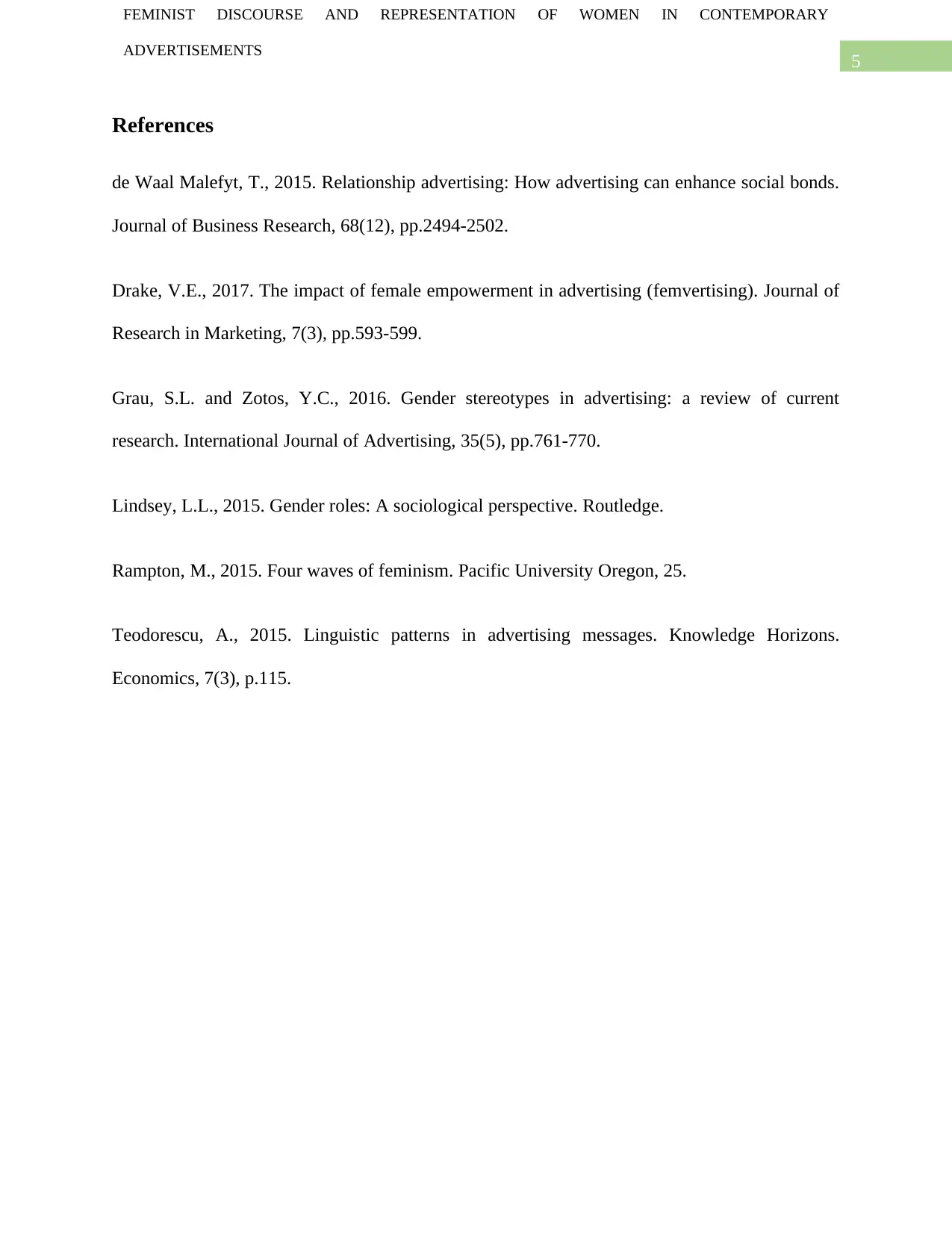
5
FEMINIST DISCOURSE AND REPRESENTATION OF WOMEN IN CONTEMPORARY
ADVERTISEMENTS
References
de Waal Malefyt, T., 2015. Relationship advertising: How advertising can enhance social bonds.
Journal of Business Research, 68(12), pp.2494-2502.
Drake, V.E., 2017. The impact of female empowerment in advertising (femvertising). Journal of
Research in Marketing, 7(3), pp.593-599.
Grau, S.L. and Zotos, Y.C., 2016. Gender stereotypes in advertising: a review of current
research. International Journal of Advertising, 35(5), pp.761-770.
Lindsey, L.L., 2015. Gender roles: A sociological perspective. Routledge.
Rampton, M., 2015. Four waves of feminism. Pacific University Oregon, 25.
Teodorescu, A., 2015. Linguistic patterns in advertising messages. Knowledge Horizons.
Economics, 7(3), p.115.
FEMINIST DISCOURSE AND REPRESENTATION OF WOMEN IN CONTEMPORARY
ADVERTISEMENTS
References
de Waal Malefyt, T., 2015. Relationship advertising: How advertising can enhance social bonds.
Journal of Business Research, 68(12), pp.2494-2502.
Drake, V.E., 2017. The impact of female empowerment in advertising (femvertising). Journal of
Research in Marketing, 7(3), pp.593-599.
Grau, S.L. and Zotos, Y.C., 2016. Gender stereotypes in advertising: a review of current
research. International Journal of Advertising, 35(5), pp.761-770.
Lindsey, L.L., 2015. Gender roles: A sociological perspective. Routledge.
Rampton, M., 2015. Four waves of feminism. Pacific University Oregon, 25.
Teodorescu, A., 2015. Linguistic patterns in advertising messages. Knowledge Horizons.
Economics, 7(3), p.115.
⊘ This is a preview!⊘
Do you want full access?
Subscribe today to unlock all pages.

Trusted by 1+ million students worldwide
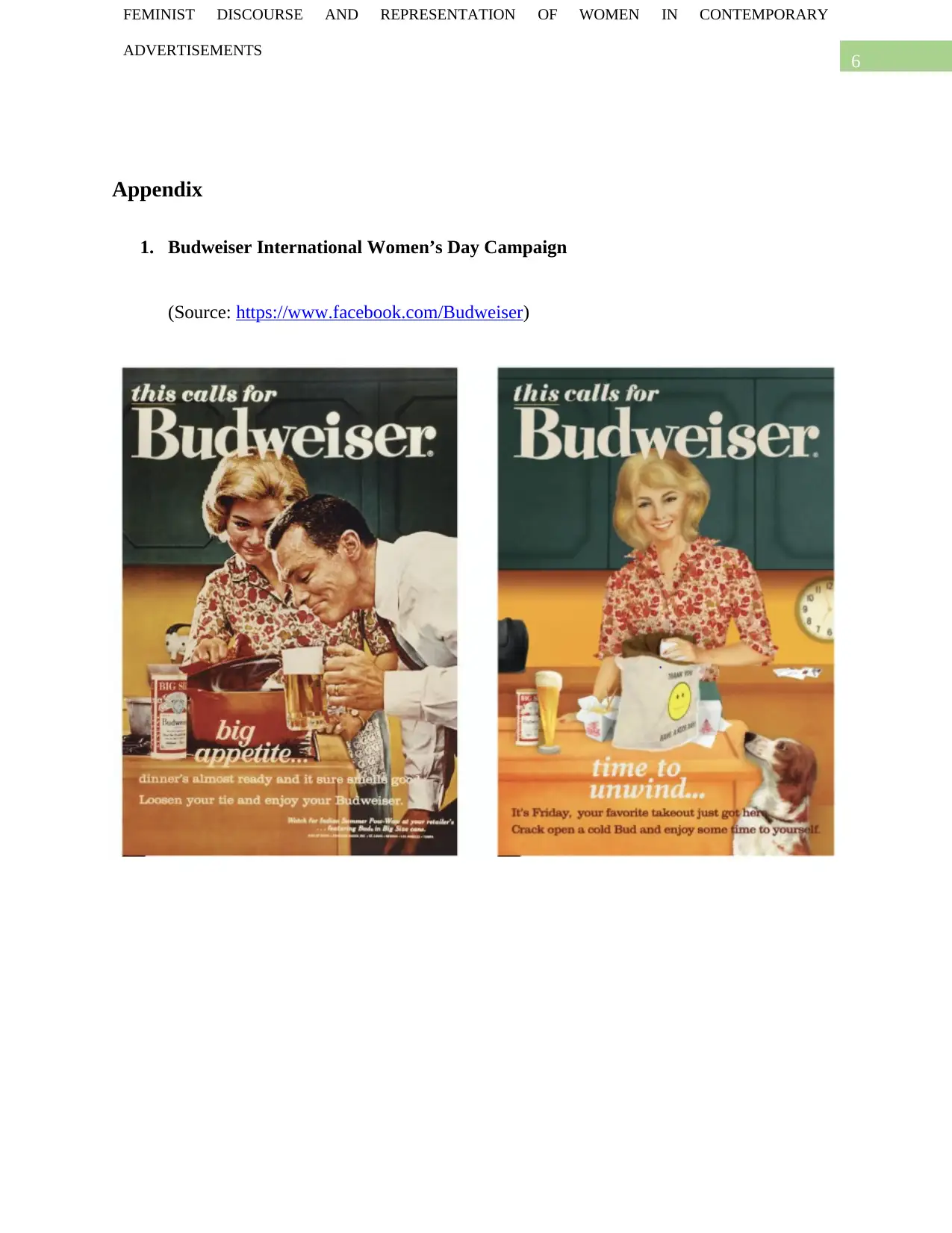
6
FEMINIST DISCOURSE AND REPRESENTATION OF WOMEN IN CONTEMPORARY
ADVERTISEMENTS
Appendix
1. Budweiser International Women’s Day Campaign
(Source: https://www.facebook.com/Budweiser)
FEMINIST DISCOURSE AND REPRESENTATION OF WOMEN IN CONTEMPORARY
ADVERTISEMENTS
Appendix
1. Budweiser International Women’s Day Campaign
(Source: https://www.facebook.com/Budweiser)
Paraphrase This Document
Need a fresh take? Get an instant paraphrase of this document with our AI Paraphraser
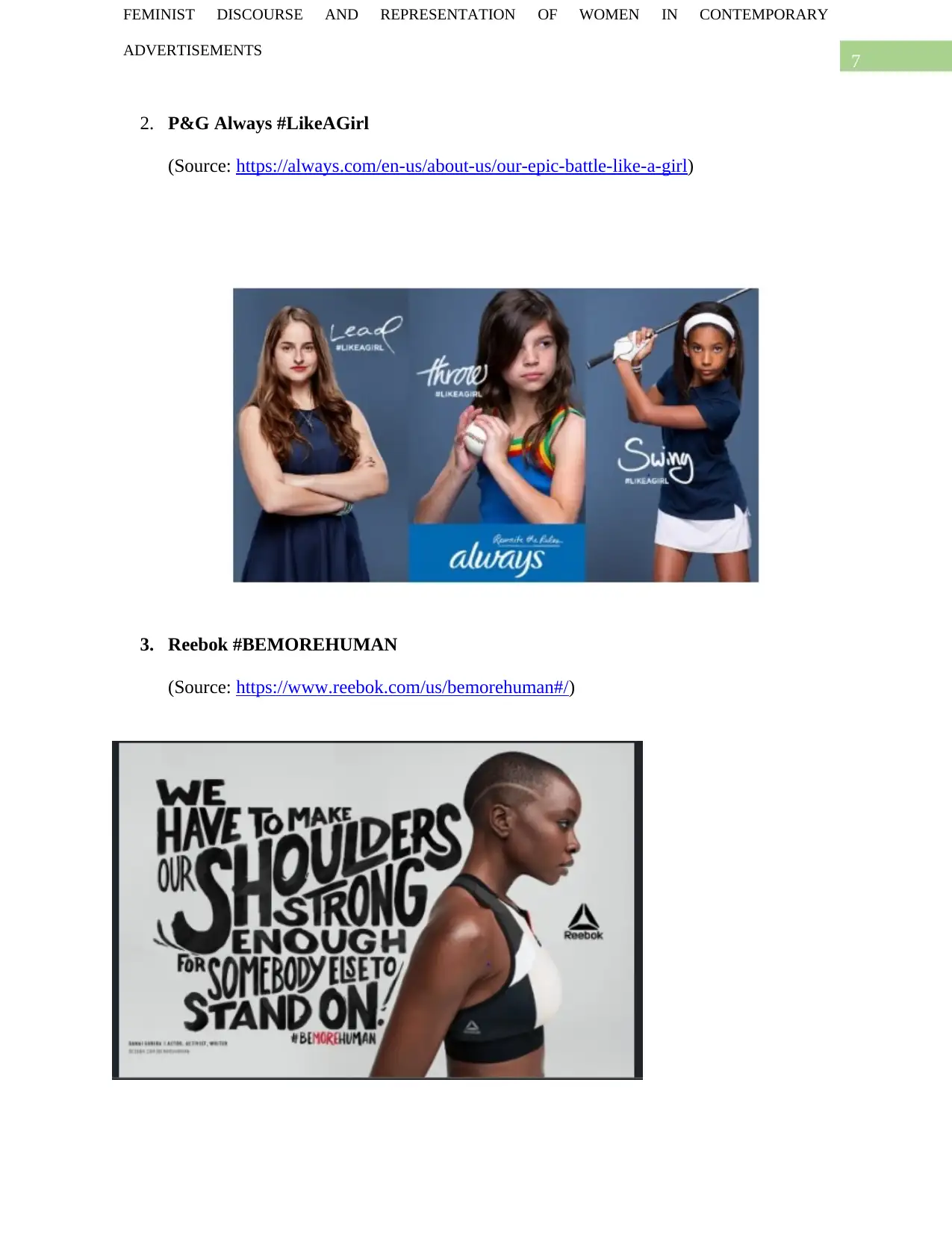
7
FEMINIST DISCOURSE AND REPRESENTATION OF WOMEN IN CONTEMPORARY
ADVERTISEMENTS
2. P&G Always #LikeAGirl
(Source: https://always.com/en-us/about-us/our-epic-battle-like-a-girl)
3. Reebok #BEMOREHUMAN
(Source: https://www.reebok.com/us/bemorehuman#/)
FEMINIST DISCOURSE AND REPRESENTATION OF WOMEN IN CONTEMPORARY
ADVERTISEMENTS
2. P&G Always #LikeAGirl
(Source: https://always.com/en-us/about-us/our-epic-battle-like-a-girl)
3. Reebok #BEMOREHUMAN
(Source: https://www.reebok.com/us/bemorehuman#/)
1 out of 8
Related Documents
Your All-in-One AI-Powered Toolkit for Academic Success.
+13062052269
info@desklib.com
Available 24*7 on WhatsApp / Email
![[object Object]](/_next/static/media/star-bottom.7253800d.svg)
Unlock your academic potential
Copyright © 2020–2025 A2Z Services. All Rights Reserved. Developed and managed by ZUCOL.




